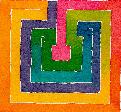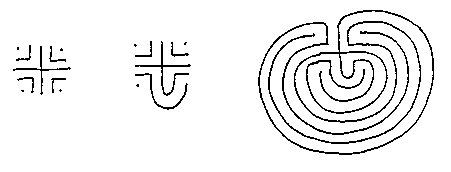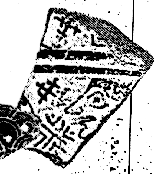| Through Mazes |
 |
to Mathematics |
| Through Mazes |
 |
to Mathematics |

The Cretan maze can be drawn as a game, a kind of systematic doodle: start with a cross, four L's and four dots as shown on the left and then join up the ends of the figure by arcs, beginning with a central pair and then always using the next two ends, one from each side. What results is a maze that can be traversed completely by a single path beginning at the outside and ending up at the center.
 This game must be very old, since this same design (in
rectangular form)
occurs on the back
of a clay tablet found in the ruins of the palace of King
Nestor in Pylos, in western Greece.
According to Hermann Kern (Labyrinthe, Prestel-Verlag,
Munich 1983)
the tablet, measuring 7 by 5.7 cm.,
was hardened in the fire that destroyed the
palace around 1200 BC and, furthermore, the way the
scratches are
made strongly suggests that it was drawn from its
nucleus, just as in our figure, except that the connecting
arcs are squared off rather than rounded.
This game must be very old, since this same design (in
rectangular form)
occurs on the back
of a clay tablet found in the ruins of the palace of King
Nestor in Pylos, in western Greece.
According to Hermann Kern (Labyrinthe, Prestel-Verlag,
Munich 1983)
the tablet, measuring 7 by 5.7 cm.,
was hardened in the fire that destroyed the
palace around 1200 BC and, furthermore, the way the
scratches are
made strongly suggests that it was drawn from its
nucleus, just as in our figure, except that the connecting
arcs are squared off rather than rounded.
 Recently (9/29/92) the
New York Times, in a report on excavations of the Philistine
city at Ashkelon, in Israel, conducted under the direction of
Prof. Lawrence Stager of the Semitic Museum at Harvard, ran this
photograph of a pottery shard found in the ruins. Painted on the
shard is, quite unmistakably, a copy of the nucleus for the
Cretan maze. The layer in
which it was found is dated around 604 BC; I believe this is
the earliest instance known of the Cretan nucleus drawn by itself.
The accompanying text states that this and other designs show
Greek influence on the Philistine culture.
Recently (9/29/92) the
New York Times, in a report on excavations of the Philistine
city at Ashkelon, in Israel, conducted under the direction of
Prof. Lawrence Stager of the Semitic Museum at Harvard, ran this
photograph of a pottery shard found in the ruins. Painted on the
shard is, quite unmistakably, a copy of the nucleus for the
Cretan maze. The layer in
which it was found is dated around 604 BC; I believe this is
the earliest instance known of the Cretan nucleus drawn by itself.
The accompanying text states that this and other designs show
Greek influence on the Philistine culture.
Return to Main Maze Page
Return to Tony's Home Page